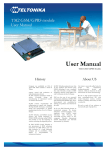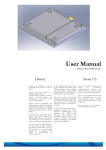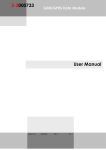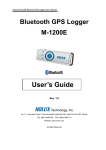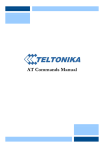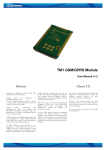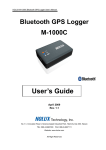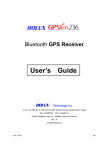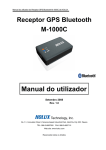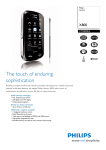Download Teltonika user manual 2007 02 07
Transcript
User Manual TM2 GSM/GPRS Module History Company was established on 15th of April 1998. Main residence is based in Vilnius. ompany started with production of telecommunication devices. In 2001 company expanded its fields of activity by starting design and manufacturing of electronical systems for wireless data transfer. In 2002 contract of partnership and collaboration was signed with company Pro-Sign GmbH (Germany), considering design and representation of graphic programming interface iCon-L in Eastern Europe. In 2003 Teltonika and NOKIA became partners and started integration of NOKIA M2M technology using NOKIA N12 module. It was the beginning of wireless technology development process. In 2004, NOKIA invited Teltonika to join presentation of M2M technology innovations in CeBIT 2004. It was very high evaluation of a small Lithuanian company and its possibilities, which helped to feel peculiarities of international business. About US In 2004 Teltonika produced more than 10 new products and solutions using EDGE technology. It was a condition that made Teltonika a leader of M2M integration solutions using EDGE not only in Lithuania, but also in Europe. 2005 was the year of two successful international exhibitions: CEBIT 2005 and HANNOVER MESSE 2005. These shows opened new possibilities for offering our products and solutions for all world. In the year 2005 Teltonika became an international company. We became Lithuanian - Finnish Company. A few employees from NOKIA joined Teltonika’s staff. Presently they successfully develop activity of new companies: Teltonika International GmbH (Düsseldorf) and Teltonika International Oy (Helsinki). Our vision is to provide added value for people and companies by creating electronical devices and solutions, which are based on the latest achievements of science and technology. We aim to help people to integrate the latest technologies in real life, what would bring more cosiness, comfort, freedom of mobility and security to their everyday life. We seek to make all our solutions an inconceivable part of people lives. Table of Contents 1 Document Mission 1.1 Glossary 1.2 Scope of Product 1.3 Power Management 1.4 Interface 1.5 Miscellaneous features 2 Product functions 2.1 System Features 2.2 Modem 2.2.1 Mechanical characteristics 2.2.2 Power supply 2.2.2.1 Current consumptions 2.2.2.2 Power Saving 2.2.3 GSM/GPRS modem functionalities 2.2.4 Supplementary servines 2.2.5 Short Message Service 2.2.6 SIM Functionality 2.2.7 AT-command support 2.2.8 Other basic features 3 User Interfaces 3.1 SIM Interface 3.2 Battery 3.3 Antenna interface 3.4 Asynchronous Serial interface 3.5 GPIO 3.6 SW interfaces 3.7 Audio devices 3.7.1 Handset 3.7.2 Headset 3.7.3 Microphone 3.7.4 Hands-free 3.7.5 Polyphonic ringer 3.7.6 ADC interface / Measurement interface 3.7.7 SPI 3.7.8 I2C bus interface 3 3 5 6 6 6 7 7 10 11 11 12 14 15 16 16 16 16 16 17 19 20 20 21 21 22 27 27 27 27 27 27 28 28 28 2 1 Document Mission The TM2 User Manual provides all information necessary for a successful integration of TM2 module into the application of the customer. Additionally, TM2 User Manual contains all product functions for application. 1.1 Glossary Abbreviation / Term ADC ADN AFC AND AMR API ASC BCCH BDN CB CBCH CCCH CD CGU CLI CSD DAI DCE DCS DCXO DL DSP DSR DTE DTMF DTR EBU EFR EGSM Explanation / Definition Analog-to-Digital Converter Abbreviated Dialling Numbers Automatic Frequency Correction Abbreviated Dialing Number Adaptive Multi Rate Application Programming Interface Asynchronous Serial Interface Controller Broadcast Control Channel Barred Dialing Number Cell Broadcast Cell Broadcast Channel Common Control Channel Carrier Detect Clock Generation Unit Calling Line Identifcation Circuit Switched Data Digital Audio Interface Data Communication Equipment Digital Cellular System (1800 MHz) Digital Controlled Crystal Oscillator Reception Digital Signal Processor Data Set Ready Data Terminal Equipment Dual Tone Multi Frequency Data Transmit Receive External Bus Interface Unit Enhanced Full Rate Extended - Global System for Mobile Communication 3 EMS ESD ETSI FDN FFS FR GPIO GPP GPRS GSM Enhanced Messaging Service Electro Static Discharge European Telecommunications Standards Institute Fixed Dialing Number Flash File System Full Rate General Purpose Input/Output 3rd Generation Partnership Project General Packet Radio System Global System for Mobile Communication HR Half Rate HW Hardware IC Integrated Circuit I2C Inter-Integrated Circuit IIR Infinite Impulsive Response IMEI International Mobile Equipment Identity JTAG LDN M2M ME Joint Test Action Group Last Dialing Number Machine-to-Machine Mobile Equipment MIDI MS MSC N-AMR NOM NV PA PC PBCCH PCCCH PCS PDP PDU PLMN PPS PST PWM RF RTC RX Musical Instrument Digital Interface Mobile Station Multi-Slot Class Narrow-AMR Network Operating Mode Non Volatile Power Amplifier Personal Computer Packet Broadcast Control Channel Packet Common Control Channel Personal Communication Service Packet Data Protocol Protocol Data Unit Public Land Mobile Network Protocol and Parameter Selection Protocol Stack Pulse Width Modulation Radio Frequency Real Time Clock Receiver 4 SAW SDN SIM SMA SMS SMS MO SMS MT SPMidi SPI SSC STK SW TCH TX UART UL 1.2 Surface Acoustic(al) Wave Service Dialing Number Subscriber Identity Module SubMiniature version A connector Short Message Service Short Message Service Mobile-Originated Short Message Service Mobile-Terminated Scalable Polyphony MIDI Serial Peripheral Interface Serial Synchronous Interface Controller SIM Toolkit Software Traffic Channel Transmitter Universal Asynchronous Receiver-Transmitter Transmission Scope of Product TM2 is a small, light weight and low power consumption module that enables digital communications services on GSM/GPRS networks for machine to machine or user to machine wireless applications. TM2 modules are developed in compliance with internal and normative certification requirements. In particular, they are certified by CE approval report and Radio & Tele Terminal Equipment Directive (R&TTED) report. Requirements for lead-free components are imposed and satisfied. The product implements a quad-band MS able to operate in the frequency bands GSM 850 MHz, EGSM 900 MHz, and DCS 1800 MHz and PCS 1900 MHz; the dynamic behavior can be configured dynamically by disabling/enabling a specific band e.g. through AT commands. Eventually, the module can be configured either dualband or tri-band or quad-band. The supported power classes for both voice and data services will be: Class 4 (2W) for GSM/EGSM bands. Class 1 (1W) for DCS/PCS bands. The product implements a Class B Mobile Station; this means the data module can be attached to both GPRS and GSM services, using one service at a time. Network operation modes I to III are supported, with user-definable preferred service between GSM and GPRS. The main buildings blocks of the module are E-GOLDlite (GSM/GPRS Baseband System, Infineon PMB7860) and E-POWERlite (Power Management, Infineon PMB6814). It’s possible connecting SIM card either with an on-board connector or with an external SIM connector. The core of TM2 module is represented by the modem, constituted from E-GOLDlite, a power amplifier (TriQuint TQM7M4006), a transceiver (Infineon SMARTi SD2 PMB6271) and a front-end (EPCOS D5005). Ignition: it takes around 800 ms to enter in AT active state (eg AT OK, see picture). From this state we have a 2 seconds setup and stabilization time before the startup signal is sent to the m2m applications. Minimum RESET time safe value is 120 ms 5 1.3 Power Management 1.4 Interface 1.5 Infineon E-POWERlite PMB6814. All the modem power rails are supplied by E-POWERlite; Battery connector. SIM card holder supporting 1.8 V and 3 V card type. MMCX Interface connector for RF output (50 Ohm connector MMCX Edge Mount SMD J01341A0081 (Telegartner)). 60 pin board-to-board connector (CVILUX CBRB060PC2000R0): Audio (2x analog, 1x digital), I2C bus, SPI bus, 2x ADC, 2x analog out (PWM), 12 GPIOs. 2 UART serial ports. Miscellaneous features 40 tones polyphonic ring tones support. 6 2 Product functions 2.1 System Features A comprehensive list of TM2’s features is presented in the following table and further detailed in the following paragraphs. The features can be shared in the following sections: Generic features; GSM/GPRS modem functionalities; Mechanical and Electronics features; Software features; Accessory support ; Host SW tools. Set of features Type approval Environmental constraints Description CE approval report available Radio & Tele Terminal Equipment Directive (R&TTED) report available Requirements for lead-free components Platform security concept description available Security Secure IMEI management Secure flashing environment Secure memory area Software update Software update using system connector Module testing SW Service software API functionality Rewrite IMEI Manage SIM locks Backup and restore user data Defect logger to analyze memory trace GSM standard compliancy ETSI GSM Phase 2+ (R99) GSM 850 MHz EGSM 900 MHz Frequency Bands DCS 1800 MHz PCS 1900 MHz Disable band/Manual band selection GPRS multi-slot class (MSC) 10 (4+1, 3+2) GPRS PBCCH/PCCCH support GSM/GPRS Data Services CBCH reception when on PBCCH supported GPRS Class B and CC Coding scheme CS-1, CS-2, CS-3, CS-4 Network operation mode I, II, III 7 Set of features Description CSD up to 9.6kbps (V.32, V.110) FAX G3, Class 2.0 Short Message Service Mobile-Terminated (SMS MT) Short Message Service Mobile-Originated (SMS MO) SMS Short message service SMS-CB Cell Broadcast (SMS CB) Concatenated SMS Via GSM or GPRS Text and PDU mode Abbreviated Dialling Numbers (ADN) Fixed Dialling Numbers (FDN) SIM Functionality Last Dialled Numbers (LDN) Service Dialling Numbers (SDN) SIM Lock protection SIM Toolkit Network Network subset SIM Locks Service provider Corporate Operator Display of Called Number Indication of Call Progress Signals Country/PLMN Indication Short Message Indication and Acknowledgement Basic Mobile Station features International Access Function Service Indicator Dual Tone Multi Frequency (DTMF) Subscription Identity Management On/Off Switch Service Provider Indication Call Hold (CH) Call Waiting (CW) Multi-Party (MTPY) GSM Supplementary services Call Forwarding (CF) Explicit Call Transfer (ECT) Call Barring (CB) Calling Line Identification Presentation (CLIP) Calling Line Identification Restriction (CLIR) 8 Set of features Description Connected Line Identification Presentation (COLP) Connected Line Identification Restriction (COLR) Unstructured Supplementary Services Data (USSD) Audio Codecs Speech codecs FR (Full rate) / EFR (Enhanced Full Rate) / HR (Half Rate) Speech codecs AMR (Adaptive Multi Rate) Encryption algorithms Mechanical features Encryption algorithms A5/1 Encryption algorithms A5/2 Number of RF shield required = 1 Number of PIN's used for SW flashing = 3 (RX/TX and Ground) RF connector Connector Board to board connector SIM holder RTC Real Time Clock (RTC) supported with alarm capabilities SIM connector on-board or external SIM voltage: 1.8 and 3 V SIM High-speed interface External SIM ESD protection required. External SIM connector support Protection circuitry integrated on the platform Battery Charging of deeply discharged battery must be possible. Charging during phone call Maximum charging current of battery :1100 mA Audio features Audio filter types supported Handsfree and headset operation Echo canceller Noise reduction Maximum number of GPIO-interfaces 12 Number of UART's 2 I/O Interfaces Power on Number of free UART's for user : 1 One UART with complete 9-pin UART 1 Max speed UART 921.6 Kbps (default AT commands 115.2 kbps) One UART with only RX/TX Power on time (sec) 3 sec 9 Set of features Call Handling Description Redial missed and/or received calls (CLI) Abbreviated Dialling Full duplex Call phone Ringtones Polyphonic ringtones HR, FR, EFR, AMR Audio formats integrated with the hardware Accessory support 2.2 MIDI 1.0 iMelody Number of simultaneous polyphonic tones (without extra HW) 40 Audio headset Charger Modem The modem part provides with minimal component’s list all functionality necessary for voice and data transmission over GSM and GPRS network. The modem is divided in two separated areas surrounded by traces on which metal boxes can be soldered. The first area encloses the RF High power components and the remaining passive components of the transceiver; the second area groups baseband processor, memory, crystals and power management unit. 10 2.2.1 Mechanical characteristics The Number of RF shield required is 1. For mechanical characteristics of GSM/GPRS module refer to the following: Fig. 2.2.1.1 TM2 Dimensional layout Mechanical and environment Size Weight Operating temperature range 2.2.2 Value 33.5 mm x 38.8 mm x 5.6 mm < 10 g From -20°C to +55°C Power supply The on board power supply is derived by CviLux connector that provides a voltage value VBAT on pins 1, 3, 5, 7. The range of VBAT is between 3.5 V and 4.2 V, while typically its value is 3.8 V. Description Min Typ Max Supply voltage 3.5 V 3.8 V 4.2 V 11 2.2.2.1 Current consumptions Current consumptions of TM2 module are reported in the following pages. Power OFF current is < 30 μA. BAND: GSM900 TEST SETTINGS: DRX: 5; BA LIST arfcn: 1 9 17 26 34 42 50 58 67 75 83 91 99 108 116 124; PCL: 5. BAND: GSM1800 TEST SETTINGS: DRX: 5 BA LIST arfcn: 512 530 560 580 610 640 670 700 720 740 760 790 810 840 860 PCL: 0 12 BAND: GSM1900 TEST SETTINGS: DRX: 5 BA LIST arfcn: 512 530 550 570 590 610 630 650 670 690 710 730 750 770 790 PCL: 0 13 2.2.2.2 Power Saving Power saving is a special function that allows the reducing of power consumption during the idle time. If the clock increases, required power increases too. Therefore a solution for minimizing the power is the reducing of the master clock frequency when there aren’t activities. In this period the system doesn’t work with a clock of 26 MHz (“fast clock”) but with a clock of 32 KHz (RTC clock or “slow clock”). This switching between 26 MHz and 32 KHz clock is performed by SCCU (Standby Clock Control Unit). Main priorities of power saving are the following: 1. Reduce base (min) current consumption. 2. Minimize full-speed running periods, minimize power saving on/off switching. 3. Reduce max current consumption. These points are reported in the following figure: 14 2.2.3 GSM/GPRS modem functionalities TM2 GSM/GPRS module integrates a full-featured R99 GSM-GPRS Protocol Stack, whose main characteristics are listed in the following. Refer to the Teltonika PICS/PIXIT documentation for a detailed description of the Stack features. The module can be configured either dual-band or tri-band or quad-band. The product implements a quad-band MS able to operate in the frequency bands GSM 850 MHz, EGSM 900 MHz, DCS 1800 MHz and PCS 1900 MHz; the dynamic behavior can be configured dynamically by disabling/enabling a specific band e.g. through AT commands. The supported power classes for both voice and data services will be: Class 4 for GSM band. Class 1 for DCS bands. The product implements a Class B Mobile Station; this means the data module can be attached to both GPRS and GSM services, using one service at a time. Network operation modes I to III are supported, with user-definable preferred service between GSM and GPRS. Optionally paging messages for GSM calls can be monitored during GPRS data transfer in not-coordinating network operation mode NOM II-III. PBCCH/PCCCH logical channels are supported, as well as CBCH reception. GPRS multislot 10 is implemented, implying a maximum of 4 slots in DL (reception) and 2 slots in UL (transmission) and 5 slots on the whole. Finally TM2 GSM/GPRS module supported: All coding schemes from CS1 to CS4. As for the circuit switched services, speech channel modes HR and FR version 1, 2 and 3 (FR, HR, EFR, N-AMR) are supported. Encryption algorithms A5/1 and A5/2 for GSM for GPRS are supported; CS Data calls are supported in transparent/non transparent mode up to 9.6 kbps. Bearer service fax Group 3 Class 2.0 is supported. Among access interfaces to DTE, both V.32 and V.110 are provided. 15 2.2.4 Supplementary servines The following supplementary services are provided: Call Hold (CH). Call Waiting (CW). Multi-Party (MTPY). Call Forwarding (CF). Explicit Call Transfer (ECT). Call Barring (CB). Calling Line Identification Presentation (CLIP). Calling Line Identification Restriction (CLIR). Connected Line Identification Presentation (COLP). Connected Line Identification Restriction (COLR). Unstructured Supplementary Services Data (USSD). 2.2.5 Short Message Service Mobile-originated as well as mobile-terminated SMS are supported. Text and PDU mode are supported. Reception of SMS during circuit-switched calls is supported. Reception of SMS via GPRS is also supported. SMS SIM storage is provided. 2.2.6 SIM Functionality Among SIM functionalities, the following services of the SIM are supported: Abbreviated Dialing Numbers (ADN). Fixed Dialing Numbers (FDN). Last Dialed Numbers (LDN). Service Dialing Numbers (SDN). ME Personalization (SIM Lock). ME Personalization handling is a mechanism to tie the ME operation to one specific SIM card or to a limited range of SIM cards from a given Network Operator or Service Provider. The ME will only accept the SIM if there is a positive match between the personalization code group(s) stored in the ME and the code group(s) belonging to the inserted SIM. The SIM Lock feature supported by TM2 GSM/GPRS module enables ME personalization through the following personalization categories: Network lock. Network subset lock. Service provider lock. Corporate lock. Operator lock. SIM Toolkit R 99 is supported. For a detailed description of the STK features, refer to the PICS/PIXIT documentation. 2.2.7 AT-command support The modem functionalities and services are provided through a rich serial ATcommand interface. All supported standard as well as proprietary AT commands are detailed in the table of SW interface. 2.2.8 Other basic features Within the scope of the M2M or user interface, the following indications and functionalities are supported: Display of Called Number. Indication of Call Progress Signals. 16 Country/PLMN Indication. Short Message Indication and Acknowledgement. International Access Function. Service Indicator. Dual Tone Multi Frequency (DTMF). Subscription Identity Management. Service Provider Indication. Abbreviated Dialing. Power on (external input). 3 User Interfaces PIN OUT description A 60-pin connector is provided to interface of TM2 module for the power supply, SIM interface, audio interface (2 x analog, 1x digital), I2C bus, SPI bus, 2 x analog in (ADC), 2 x analog out (PWM), 2 UART serial ports, and 12 GPIOs (maximum number). 3.1 Table Pin Out Description PIN Name I/O Function I/O type From 3.3 to 4.3 V (Typ: 3.8 V) 1 VBAT PWR GSM Power Supply 2 GND PWR GSM Power Supply Ground 3 VBAT PWR GSM Power Supply From 3.3 to 4.3 V (Typ: 3.8 V) 4 GND PWR GSM Power Supply Ground 5 VBAT PWR GSM Power Supply From 3.3 to 4.3 V (Typ: 3.8 V) 6 GND PWR GSM Power Supply Ground 7 VBAT PWR GSM Power Supply From 3.3 to 4.3 V (Typ: 3.8 V) 8 GND PWR GSM Power Supply Ground 9 VCHARG E PWR GSM Power Supply 10 DCD O Asynchronous Serial Interface 0 11 VCHARG E PWR GSM Power Supply 12 DTR I Asynchronous Serial Interface 0 13 SIM_VCC I/O SIM interface 14 CTS_0 I Asynchronous Serial Interface 0 15 SIM_IO I/O SIM interface 16 RTS_0 O Asynchronous Serial Interface 0 17 SIM_CLK O SIM interface 0 - 12V (Typ: 6V) Current limited to 600 mA CMOS 3.3V compatible 0 - 12V (Typ: 6V) Current limited to 600 mA CMOS 3.3V compatible Supply 1.8V3.3V CMOS 3.3V compatible CMOS 3.3V compatible CMOS 3.3V compatible CMOS 3.3V compatible Description Should be connected with pins 3, 5, 7 Should be connected with pins 4, 6, 8 Should be connected with pins 1, 5, 7 Should be connected with pins 2, 6, 8 Should be connected with pins 1, 3, 7 Should be connected with pins 2, 4, 8 Should be connected with pins 1, 3, 5 Should be connected with pins 2, 4, 6 Should be connected with pin 11 Data Carrier Detect Should be connected with pin 9 Data Terminal Ready SIM power supply Clear To Send SIM I/O serial data Request to Send SIM clock signal 17 18 RXD_0 I Asynchronous Serial Interface 0 19 SIM_RST O SIM interface 20 TXD_0 O 21 MRST0/G PIO I/O 22 RI O 23 MTSR0/G PIO I/O 24 DSR O 25 SCLK0/G PIO I/O 26 RXD_1 I 27 SCL/GPI O O I2C bus interface 28 TXD_1 O Asynchronous Serial Interface 1 I/O I2C bus interface 29 30 31 32 33 34 35 36 37 38 SDA/GPI O KEYOUT 0/GPIO CLK0_DA I/GPIO KEYOUT 1/GPIO RXD_DAI /GPIO KEYOUT 2/GPIO TXD_DAI /GPIO KEYOUT 3/GPIO WA0_DAI /GPIO KEYOUT 4/GPIO I/O I/O I/O I I/O O I/O I/O I/O Asynchronous Serial Interface 0 Synchronous Serial Interface (SPI compatible) Asynchronous Serial Interface 0 Synchronous Serial Interface (SPI compatible) Asynchronous Serial Interface 0 Synchronous Serial Interface (SPI compatible) Asynchronous Serial Interface 1 Keypad interface / GPIO Digital Audio Interface Keypad interface / GPIO Digital Audio Interface Keypad interface / GPIO Digital Audio Interface Keypad interface / GPIO Digital Audio Interface Keypad interface / GPIO 39 EXTRSTn I External reset 40 KEYOUT 5/GPIO I/O Keypad interface / GPIO 41 MICP1 I Audio Interface 42 KEYIN0/ GPIO I/O Keypad interface / GPIO 43 MICN1 I Audio Interface 44 KEYIN1/ GPIO I/O Keypad interface / GPIO 45 EPPA1B O Audio Interface 46 KEYIN2/ ON I/O Keypad interface / Power on CMOS 3.3V compatible CMOS 3.3V compatible CMOS 3.3V compatible CMOS 3.3V compatible CMOS 3.3V compatible CMOS 3.3V compatible CMOS 3.3V compatible CMOS 3.3V compatible CMOS 3.3V compatible CMOS 3.3V compatible CMOS 3.3V compatible CMOS 3.3V compatible CMOS 3.3V compatible CMOS 3.3V compatible CMOS 3.3V compatible CMOS 3.3V compatible CMOS 3.3V compatible CMOS 3.3V compatible CMOS 3.3V compatible CMOS 3.3V compatible CMOS 3.3V compatible CMOS 3.3V compatible CMOS 3.3V compatible Analog CMOS 3.3V compatible Analog CMOS 3.3V compatible Analog CMOS 3.3V compatible Receive Serial Data SIM reset signal Transmit Serial Data Master Receive Slave Transmit Ring Indicator Master Transmit Slave Receive Data Set Ready Shift Clock Receive Serial Data Serial Clock Line Transmit Serial Data Serial Data Line Keypad output pin 0 / GPIO 00 DAI Clock Keypad output pin 1 / GPIO 50 DAI Receive Keypad output pin 2 / GPIO 01 DAI Transmit Keypad output pin 3 / GPIO 02 DAI Reset Keypad output pin 4 / GPIO 03 External HW reset Keypad output pin 5 / GPIO 04 Handset microphone reference Keypad input pin 0 / GPIO 05 Handset microphone bias Keypad input pin 1 / GPIO 06 Balanced audio out Keypad input pin 2 / Power on button /GPIO 07 18 47 EPPA2A O Audio Interface 48 KEYIN3/ GPIO I/O Keypad interface / GPIO 49 MICP2 I Audio Interface 50 CAP19/G PIO I/O Capture Compare / GPIO 51 MICN2 I Audio Interface 52 CAP02/G PIO I/O Capture Compare / GPIO 53 AUOP O Audio Interface 54 CAP05/G PIO I/O Capture Compare / GPIO 55 AUON O Audio Interface 56 CAP06/G PIO I/O 57 ADC1 I 58 CAP00_E X5IN/GPI O I/O 59 ADC2 I 60 CAP22_E X3IN/GPI O I/O Capture Compare / GPIO Measurement interface Capture Compare / GPIO / External Interrupt Measurement interface Capture Compare / GPIO / External Interrupt Analog CMOS 3.3V compatible Analog CMOS 3.3V compatible Analog CMOS 3.3V compatible Analog CMOS 3.3V compatible Analog CMOS 3.3V compatible ADC 12bits 02.5V CMOS 3.3V compatible ADC 12bits 02.5V CMOS 3.3V compatible Balanced audio out Keypad input pin 3 / GPIO 08 Handset microphone reference Capture Compare 19 / GPIO 47 Handset microphone bias Capture Compare 02 / GPIO 57 Balanced power audio out Capture Compare 05 / GPIO 28 Balanced power audio out Capture Compare 06 / GPIO 30 Analog to Digital Converter Capture Compare 00 / GPIO 30 / Ext Int 5B Analog to Digital Converter Capture Compare 22 / GPIO 55 / Ext Int 3 3.1 Fig. TM2 module 3.1 SIM Interface TM2 module can be equipped with an on-board SIM connector or an external SIM connector. High-speed SIM/ME interface is implemented. Both 1.8V and 3V SIM type will be supported (1.8/3V ME); activation and deactivation with automatic voltage switch from 1.8V to 3V are implemented, according to ISO-IEC 78-16-e Specifications. The SIM driver supports the PPS (Protocol and Parameter Selection) procedure for baud-rate selection, according to the values proposed by 19 the SIM Card. Clock stop is supported at both high and low level. Finally, external SIM ESD protection is required. 3.2 Name PIN # I/O I/O type Description SIM_VCC 13 I/O Supply 1.8V 3.3V SIM Power Supply SIM_IO 15 I/O CMOS 3.3V compatible SIM I/O Serial Data SIM_CLK 17 O CMOS 3.3V compatible SIM Clock Signal SIM_RST 19 O CMOS 3.3V compatible SIM Reset Signal Battery The supported type for the battery shall be Li-Ion rechargeable only; default system will support 650mAh nominal. Protection circuitry is integrated on the module. The Battery/Charger functionality provides: • battery charging control, i.e. constant voltage charging and trickling of charging in order to maintain the full capacity of the battery; • pulse charge mode, to improve capacity estimation accuracy; • capacity estimation during charging, no charging, ongoing calls, etc., constantly considering the different load parameters of the phone; • Measurements of battery voltage, RF and battery temperature, equipment status, etc. Charging of deeply discharged battery as well as charging during phone call is possible. The module has a current consumption lower than 3mA during idle mode reception, lower than 300 mA in connected mode on GSM band and lower than 180mA in connected mode on DCS band (measurements are performed following the GSM Association Battery Life Measurement Technique Document). The charging battery range goes from 400 to 1100 mA with a step of 100 mA. Name PIN # I/O I/O type Description VBAT 1 PWR From 3.3 to 4.3 V (Typ: 3.8 V) Should be connected with pins 3, 5, 7 GND 2 PWR Ground Should be connected with pins 4, 6, 8 VBAT 3 PWR From 3.3 to 4.3 V (Typ: 3.8 V) Should be connected with pins 1, 5, 7 GND 4 PWR Ground Should be connected with pins 2, 6, 8 VBAT 5 PWR From 3.3 to 4.3 V (Typ: 3.8 V) Should be connected with pins 1, 5, 7 GND 6 PWR Ground Should be connected with pins 2, 4, 8 VBAT 7 PWR From 3.3 to 4.3 V (Typ: 3.8 V) Should be connected with pins 1, 5, 7 GND 8 PWR Ground Should be connected with pins 2, 4, 6 VCHARGE 9 PWR From 0 to 12 V (Typ: 6V) Current limited to 600 mA Should be connected with pin 11 VCHARGE 11 PWR From 0 to 12 V (Typ: 6V) Current limited to 600 mA Should be connected with pin 9 3.3 Antenna interface A 50 Ohm MMCX connector is provided as antenna connector for GSM functionality. 20 3.4 Asynchronous Serial interface Two serial ports (ASC0 UART and ASC1 UART) are supported working at the selected baud rate (default 115.2 kbps): on ASC0 complete 9 pin serial port is supported and power saving wakeup is available. This interface is fullyRS232 9-pin logical compliant and support full HW flow control. Default UART configuration implies ASC0 devoted to AT interface, ASC1 available for debug/tracing (only RX/TX lines). These serial interfaces are available complying with V.24 protocol and the signals are: • TX Data (TXD_0). • RX Data (RXD_0). • Request to Send (RTS_0). • Clear to Send (CTS_0). • Data Terminal Ready (DTR). • Data Set Ready (DSR). To avoid floating if output pins are high-impedance, use pull-up resistors tied to GSM_VDD or pull-down resistors tied to GND. The first 6 pin reported in the table refer at the first serial interface, while the last two refer at the second serial interface. DCD PIN # 10 DTR 12 I CMOS 3.3V compatible Data Terminal Ready CTS_0 14 I CMOS 3.3V compatible Clear To Send Name I/O I/O type Description O CMOS 3.3V compatible Data Carrier Detect RTS_0 16 O CMOS 3.3V compatible Request to Send RXD_0 18 I CMOS 3.3V compatible Receive Serial Data TXD_0 20 O CMOS 3.3V compatible Transmit Serial Data RI 22 O CMOS 3.3V compatible Ring Indicator DSR 24 O CMOS 3.3V compatible Data Set Ready RXD_1 26 I CMOS 3.3V compatible Receive Serial Data TXD_1 28 O CMOS 3.3V compatible Transmit Serial Data 3.5 Serial interface # Asynchronous Serial Interface 0 Asynchronous Serial Interface 1 GPIO All General Purpose I/O (GPIOs) shall be initialized to proper direction / output logic level as soon as possible. If supply is removed from external device, relevant GPIOs should be placed at low logic level, or decoupled. Name PIN # I/O I/O type KEYOUT0/GPIO 30 I/O CMOS 3.3V compatible KEYOUT1/GPIO 32 I/O CMOS 3.3V compatible KEYOUT3/GPIO 36 I/O CMOS 3.3V compatible KEYOUT4/GPIO 38 I/O CMOS 3.3V compatible KEYOUT5/GPIO 40 I/O CMOS 3.3V compatible KEYIN0/GPIO 42 I/O CMOS 3.3V compatible Description Keypad output pin 0 / GPIO 00 Keypad output pin 1 / GPIO 50 Keypad output pin 3 / GPIO 02 Keypad output pin 4 / GPIO 03 Keypad output pin 5 / GPIO 04 Keypad input pin 0 / GPIO 05 21 KEYIN1/GPIO 44 I/O CMOS 3.3V compatible KEYIN3/GPIO 48 I/O CMOS 3.3V compatible CAP19/GPIO 50 I/O CMOS 3.3V compatible CAP02/GPIO 52 I/O CMOS 3.3V compatible CAP05/GPIO 54 I/O CMOS 3.3V compatible CAP06/GPIO 56 I/O CMOS 3.3V compatible Keypad input pin 1 / GPIO 06 Keypad input pin 3 / GPIO 08 Capture Compare 19 / GPIO 47 Capture Compare 02 / GPIO 57 Capture Compare 05 / GPIO 28 Capture Compare 06 / GPIO 30 Note: The General Purpose I/O is not accessible using AT commands. It could be accessible from internal M2M resusrses only. 3.6 SW interfaces The AT-command interface provides the service and the functionalities of GSM/GPRS modem. It is possible observe the AT commands of TM2 module in the following table. Command description General Commands AT+CGMI Manufacturer identification AT+CGMM Request model identification AT+CGMR Request revision identification AT+CGSN Request product serial number identification AT+CSCS Set TE character set AT+CIMI Request international mobile subscriber identification AT+CCID Card identification AT+GCAP Request complete capability list A/ Repeat last command Mobile equipment control and status commands AT+CPAS Phone activity status AT+CPWROFF Switch off the MS AT+CFUN Set phone functionality AT+CBC Battery charge AT+CIND Indicator control AT+CMER Mobile termination event reporting AT+CCLK Clock AT+CALA Alarm AT+CRSM Restricted SIM access AT+CALM Alert sound mode AT+CRSL Ringer sound level AT+CLVL Loudspeaker volume level AT+CMUT Mute control AT+CCWE Call meter maximum event AT+CSGT Set greeting text AT+CALD Delete alarm AT+CTZU Automatic Time Zone Update AT+CTZR Time Zone Reporting Name 22 AT+CLAC AT+CMEE AT+CSTA ATD ATT ATP ATA ATH ATM ATL AT+CMOD AT+CHUP AT+CEER AT+VTD AT+VTS ATDL ATS0 AT+CNUM AT+CSQ AT+COPS AT+CREG AT+CPOL AT+COPN AT+CPIN AT+CLCK AT+CPWD AT+CPBS AT+CPBR AT+CPBF AT+CPBW AT+CSMS AT+CPMS AT+CMGF AT+CSAS AT+CRES AT+CSDH AT+CNMI AT+CMGR AT+CNMA AT+CMGL AT+CMGS AT+CMGW AT+CMSS List all available AT commands Report mobile termination error Call control commands Select type of address Dial command (full support of modifiers: ;,>,I,G) Select tone dialing Select pulse dialing Call answer Hook control Monitor speaker mode Monitor speaker loudness Call mode Hang up call Extended error report Tone duration DTMF and tone generation Redial last telephone number Automatic answer Network service commands Subscriber number Signal quality Operator selection Network registration Preferred operator list Read operator names Security commands Enter PIN Facility lock Change password Phonebook commands Select phonebook memory storage Read phonebook entries Find phonebook entries Write phonebook entry Short message commands Select message service Preferred message storage Preferred message format Save settings Restore settings Show text mode parameters New message indication Read message New message acknowledgement to ME/TA List message Send message Write message to memory Send message from storage 23 AT+CSMP AT+CMGD AT+CSCA AT+CSCB AT+CCFC AT+CCWA AT+CLIR AT+CLIP AT+COLP AT+COLR AT+CAOC AT+CACM AT+CAMM AT+CPUC AT+CHLD AT+CTFR AT+CLCC AT+CSSN AT+CUSD AT+CCUG AT+CNAP AT+CBST AT+FCLASS AT+CR AT+CRC AT+CRLP AT+FDT AT+FDR AT+FIP AT+FKS AT+FK AT+FAA AT+FAP AT+FBS AT+FBO AT+FBU AT+FCC AT+FCQ AT+FCR AT+FCS AT+FCT AT+FEA AT+FFC AT+FHS AT+FIE Set text mode parameters Delete SMS Service center address Select cell broadcast message types Supplementary services commands Call forwarding Call waiting Calling line identification restriction Calling line identification presentation Connected line identification presentation Connected line identification restriction Advise of charge Accumulated call meter Accumulated call meter maximum Price per unit and currency table Call related supplementary services Call deflection List current list calls Supplementary service notifications Unstructured supplementary service data Closed user group Calling name presentation Data commands Select bearer service type Service class selection and identification Service reporting control Cellular result codes Radio link protocol FAX class 2.0 commands Transmit data Receive data Initialize facsimile parameters Session termination Session termination Adaptive answer Address & polling capabilities Buffer size Data bit order HDLC frame reporting DS capabilities parameters Copy quality checking Capability to receive data Current session results DTE phase C response timeout Phase C received EOL alignment Format conversion Call termination status Procedure interrupt enable 24 AT+FIS AT+FIT AT+FLI AT+FLO AT+FLP AT+FMI AT+FMM AT+FMR AT+FMS AT+FNR AT+FNS AT+FND AT+FPA AT+FPI AT+FPP AT+FPS AT+FPW AT+FRQ AT+FRY AT+FSA AT+FSP ATZ AT&F AT&C AT&D AT&S AT&K AT&W AT&V AT&Y ATI AT+GMI AT+GMM AT+GSN AT+GMR AT+ICF AT+IFC AT\Q AT+IPR ATO ATS2 ATS3 ATS4 ATS5 ATS6 ATS7 ATS8 ATS10 Current session parameters Inactivity timeout Local ID string Set flow control Indicate document to poll Request manufacturer identification Request model identification Request revision identification Minimum phase C speed Negotiation reporting Non-standard frame FIF octet string NSF message data indication Selective polling address Local polling ID string Packet protocol control Page status Password parameter Receive quality thresholds Error correction mode retry count Sub Address parameter Request to poll V.24 control and V.25ter commands Reset to default configuration Set to factory defined configuration Circuit 109 (CD) behavior Circuit 108/2 (DTR) behavior DSR override Flow control Store current configuration Display current configuration Designate a default reset profile Request identification information Request manufacturer identification Request model identification Request product serial number identification Request revision identification DTE-DCE character framing DTE-DCE local flow control Set flow control Fixed DTE rate Return to on-line data state Escape character Command line termination character Response formatting character Command line editing character Pause before blind dialing Connection completion timeout Command dial modifier time Automatic disconnect delay 25 ATS12 ATE ATQ ATV Escape prompt delay (EPD) Command echo Result code suppression DCE response format Result code selection and call progress monitoring ATX control Specific AT commands AT# Production test command AT+CGED GPRS cell environment description AT+TRACE Switch on/off trace AT+XBANDSEL Select band AT+XCALLSTAT Set reporting call status AT+XGENDATA Display generation and SW version AT+XGCNTRD Read counters of sent or received GPRS data AT+XGCNTSET Set/reset counter of sent or received GPRS data AT+XHANDSFREE Set hands free mode AT+XL1SET Call the L1-specific function AT+XSIO Configuration trace and modem (AT) interfaces AT+NADC ADC read command AT+NGPIOC GPIO select configuration command AT+NGPIOR GPIO read command AT+NGPIOW GPIO set command AT+NRNG Ringer select command SIM toolkit AT+STKPRO SIM-APPL-TK proactive commands AT+STKTR SIM-APPL-TK terminal response AT+STKENV SIM-APPL-TK envelope AT+STKPROF SIM-APPL-TK terminal profile AT+STKCC SIM-APPL-TK call control commands AT+STKCNF SIM-APPL-TK proactive session status GPRS AT commands AT+CGDCONT Define PDP context AT+CGEREP GPRS event reporting AT+CGQREQ Quality of service profile (requested) AT+CGQMIN Quality of service profile (minimum acceptable) AT+CGATT GPRS attach or detach AT+CGACT PDP context activate or deactivate AT+CGDATA Enter data state Automatic response to a network request for PDP AT+CGAUTO context activation AT+CGPADDR Show PDP address AT+CGCLASS GPRS mobile station class AT+CGREG GPRS network registration status AT+CGSMS Select service for MO SMS messages 26 3.7 Audio devices 3.7.1 Handset A standard handset is supported for normal handset operation on the default audio path. 3.7.2 Headset One earpiece headset is supported and may be used for voice during calls. The audio path switching from handset to headset is automatic when a rising edge is detected from line CAP22_EX3XIN (Pin 60); the audio path returning to the headset when line CAP22_EX3XIN (Pin 60) return to 0 level. 3.7.3 Microphone The uplink path can be switched between the handset and the headset microphone. The path switching is driven automatically as described above for the earpiece. The uplink path can be muted. 3.7.4 Hands-free A true hands-free functionality is implemented using high power loudspeaker, MS microphone and appropriate DSP algorithms for voice band handling (Echo canceller and Automatic Gain control). The product is equipped with a power audio amplifier that can drive an external 8 ohm speaker with 400mW peak. The audio power amplifier can be used as a voice amplifier for the hands free functionality and as a melody player amplifier for ringer functionality. The melody player could be the Midi synthesizer or the tone generator. In order to minimize the clipping of the audio signal, the polarization voltage can be adapted to the voltage supply (battery voltage). The audio signal on the loudspeaker is a mono signal. 3.7.5 Polyphonic ringer Polyphonic ring-tones can be generated by an internal MIDI synthesizer, which runs at 16 or 32 KHz sample frequency and can sum up to 40 voices at 16 kHz sampling rate. The synthesizer output is only mono and cannot be mixed with TCH voice path (the two are mutually exclusive). To perform in-band alerting during TCH with voice path open, only Tone Generator can be used. The output samples of the synthesizer are post processed by two modules: • High Frequency Shelving Filter: This module is implemented as a first order IIR Filter, which is mainly used for high frequency boost in audio signals. Its transfer function can be controlled by 4 filter coefficients. • Audio Compressor: The audio compressor is a device for manipulating the dynamic range of mono or stereo audio signals. The audio compressor can be controlled by 14 configuration parameters. Polyphonic standard format supported. The MIDI driver can play: • MIDI files conforming to: General Midi Level 1.0 with file-format 0 and 1. General Midi Lite 1.0. • SPMidi (Scalable Polyphony MIDI) files conforming to: SPMidi 1.0. • iMelody files conforming to: 27 3.7.6 iMelody v.1.2 specifications. ADC interface / Measurement interface 2 inputs for Analog-to-Digital Converter are supported. The resolution of these converters is of 12-bit with a range of 0-2.5 Volt. Name PIN I/O I/O type Description ADC1 57 I ADC 12bits 0-2.5V Analog to Digital Converter ADC2 59 I ADC 12bits 0-2.5V Analog to Digital Converter 3.7.7 SPI The SPI bus includes a clock signal, and two signals for the transmissions of the master and the slave. Name PIN I/O MRST0/GPIO 21 I/O MTSR0/GPIO 23 I/O SCLK0/GPIO 25 I/O 3.7.8 I/O type CMOS compatible CMOS compatible CMOS compatible Description 3.3V 3.3V 3.3V Master Receive Slave Transmit Master Transmit Slave Receive Shift Clock I2C bus interface The I2C bus interface includes a serial clock and a serial data line. Name PIN I/O I/O type Description SCL/GPIO 27 O CMOS 3.3V compatible Serial Clock Line SDA/GPIO 29 I/O CMOS 3.3V compatible Serial Data Line 28




























